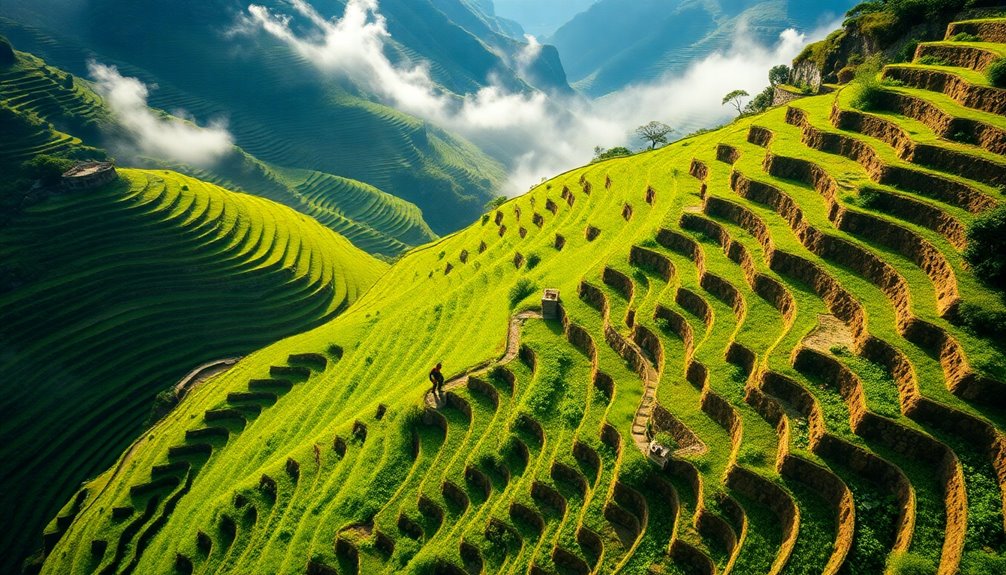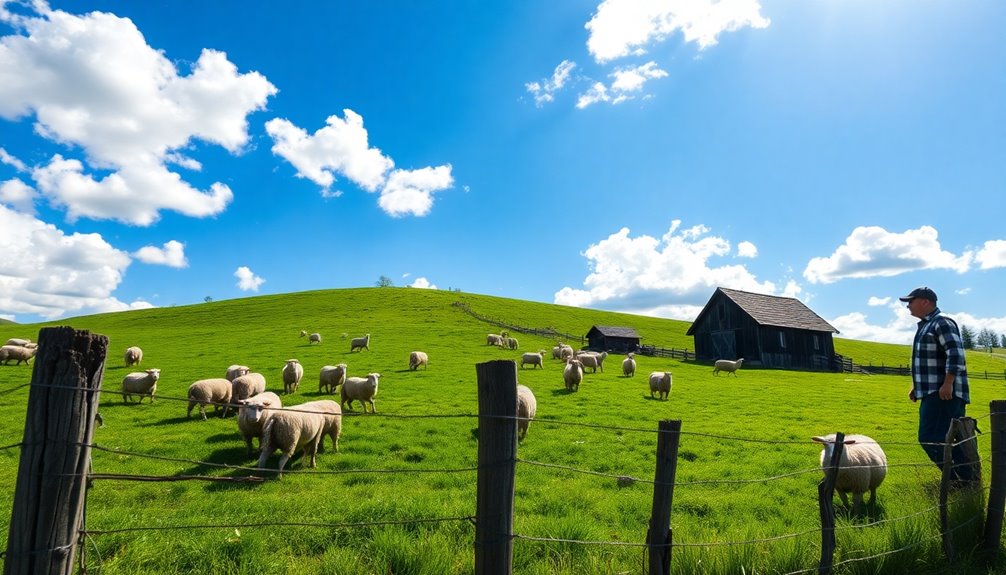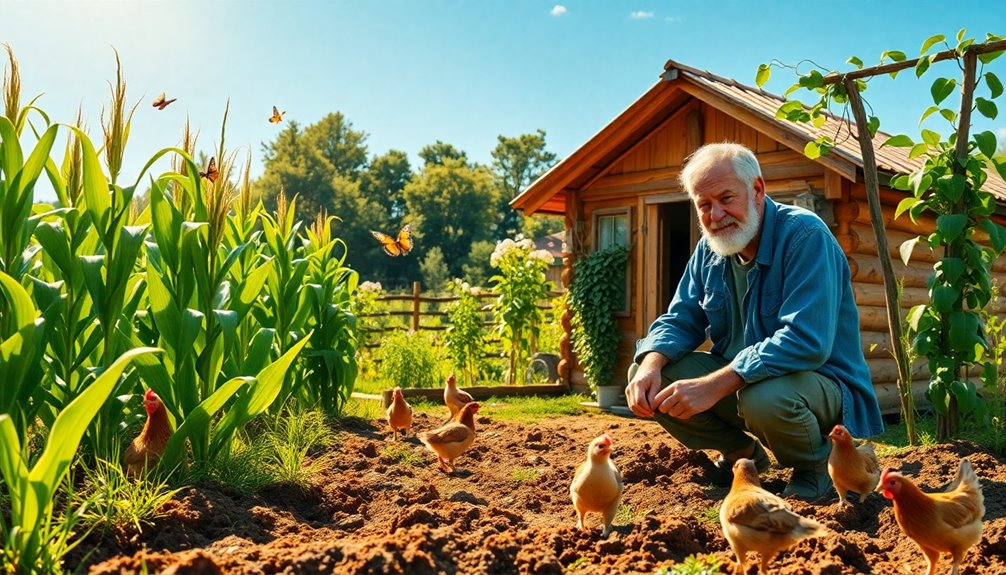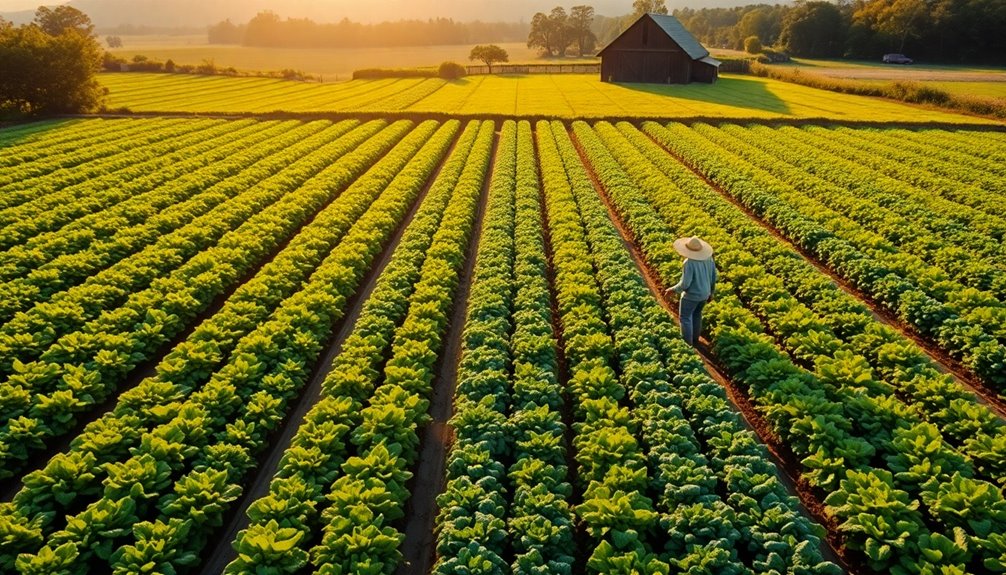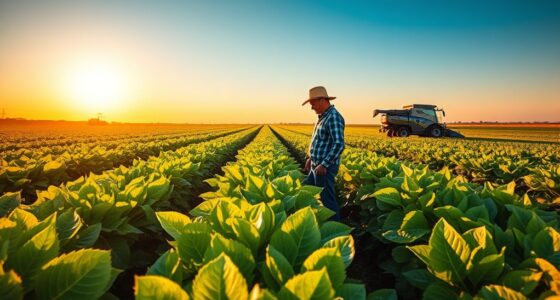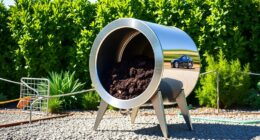Terrace farming is an effective method that converts sloped land into flat, step-like areas for agriculture. This approach maximizes your land's potential by enhancing water management and reducing soil erosion. You can grow a variety of crops while conserving soil and water. To get started, you'll need to mark contour lines, build retaining walls, and create drainage channels. Regular maintenance is essential to keep your terraces functional and productive. By implementing these steps, you can boost your agricultural output and sustain your land for future generations. Discover how to effectively set up your own terrace system to optimize your yield.
Key Takeaways
- Terrace farming involves creating flat areas on sloped land to maximize agricultural productivity and conserve soil and water resources.
- This method enhances water management and reduces soil erosion through structured step-like platforms.
- Key types include bench terracing, contour farming, and narrow-base terraces, each suited for different slopes and crops.
- The construction process involves marking contours, building retaining walls, and ensuring proper drainage for effective water management.
- Regular maintenance practices, such as soil stabilization and crop rotation, are vital for sustaining the benefits of terrace farming.
Understanding Terrace Farming
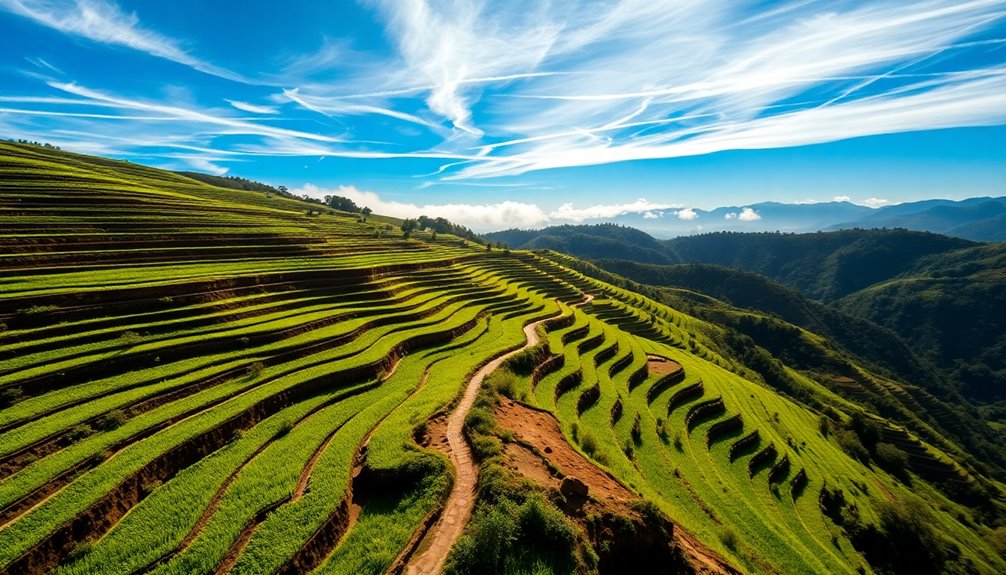
While many agricultural methods are designed for flat land, terrace farming uniquely adapts to sloped terrains, creating step-like platforms that maximize crop production.
This practice emphasizes soil conservation and effective water management, preventing erosion on steep slopes. By constructing terraces, you slow down water runoff, allowing moisture and nutrients to be retained, which boosts agricultural productivity.
This method supports sustainable agriculture by promoting biodiversity, enabling the growth of diverse crops such as rice, grains, and legumes.
Additionally, intricate irrigation systems can be integrated into terrace farming, enhancing water distribution across the fields.
Historical Context of Terrace Farming
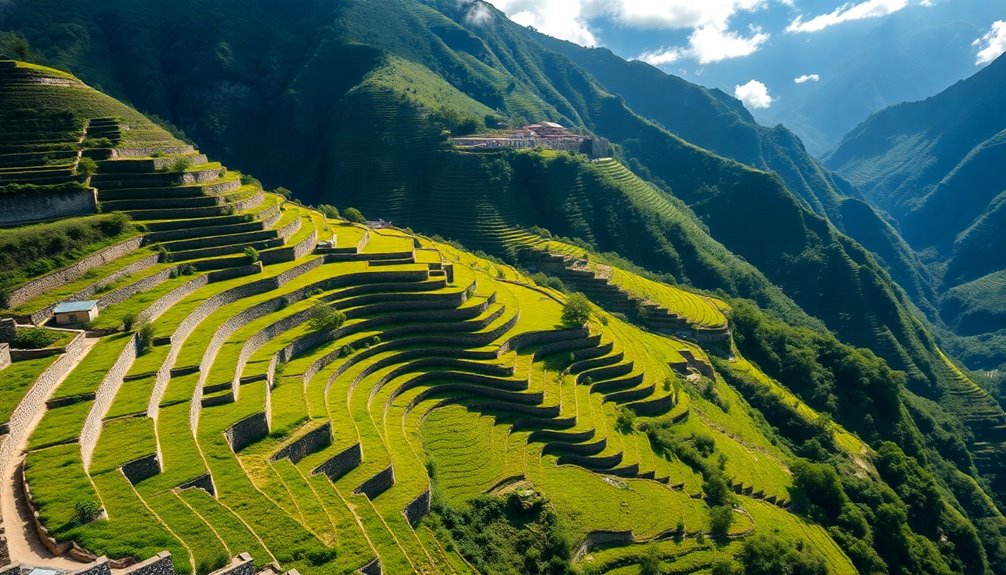
You'll find that terrace farming has roots in ancient civilizations, showcasing their innovative agricultural practices.
For example, the Inca utilized terraces to thrive in the Andes, while the Philippine Rice Terraces reflect a long-standing cultural heritage.
Today, these techniques not only enhance food systems but also underscore the significance of adapting to diverse environments.
Ancient Civilization Practices
Throughout history, ancient civilizations have demonstrated remarkable ingenuity in adapting to their environments, and terrace farming stands as a prime example of this innovation.
Consider the following:
- The tiered fields of Machu Picchu, cultivated by the Incas in the rugged Andes.
- The stunning Banaue Rice Terraces, a UNESCO World Heritage Site, crafted by the Ifugao people.
- Mesopotamian agricultural practices dating back to 4000 BC.
- The terraced landscapes of ancient China, enhancing food security in Yunnan and Sichuan.
- The Hanging Gardens of Babylon, showcasing advanced gardening techniques.
These practices highlight how ancient civilizations maximized arable land and guaranteed food security, showcasing a deep understanding of their environments and sustainable agricultural methods. Additionally, the Hopi Tribe's unique connection to the land influenced their agricultural practices, including the use of terrace farming to adapt to their arid environment.
Cultural Significance Today
Terrace farming isn't just a historical practice; it carries deep cultural significance that resonates with communities today.
You'll find that ancient rice terraces, like those of the Ifugao people in the Philippines, symbolize cultural heritage and community identity. These systems, recognized as UNESCO World Heritage Sites, showcase advanced agricultural techniques developed over 2,000 years.
In regions like the Andes and Bali, terrace farming exemplifies sustainable agriculture and effective water management, preserving traditions while adapting to hilly terrains.
As communities continue to practice these time-honored methods, they highlight the importance of maintaining a connection to their roots, ensuring that the ingenuity behind terrace farming plays a crucial role in their identity and livelihood for generations to come.
Types of Terrace Farming Systems
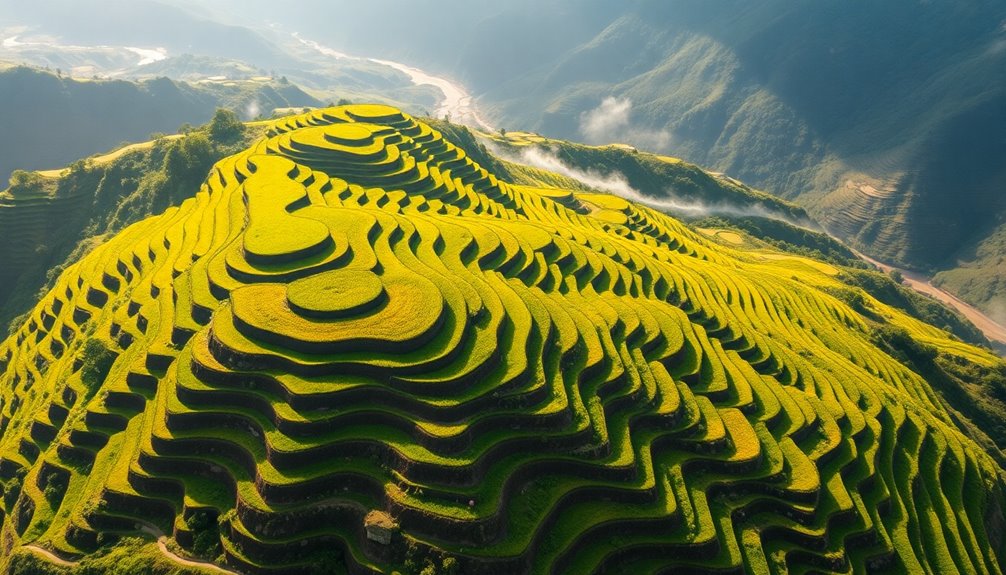
When you explore terrace farming systems, you'll find various techniques tailored to different landscapes.
Bench terracing is great for steep slopes, helping to retain water for crops like rice.
On the other hand, contour farming methods follow the land's natural shape, effectively managing water runoff while minimizing disruption to the environment.
Bench Terracing Techniques
Many farmers implement bench terracing techniques to maximize agricultural productivity on steep slopes. This method creates flat platforms supported by retaining walls, effectively reducing soil erosion and improving water retention.
Here's what to expect when using bench terracing:
- Stable, flat surfaces for easy crop production
- Enhanced irrigation management to maintain soil moisture
- Reduced water runoff that conserves resources
- Labor-intensive construction that pays off in increased arable land
- Adaptable designs based on the slope's steepness
Contour Farming Methods
Utilizing contour farming methods effectively transforms sloped land into productive agricultural areas. By implementing various terracing systems, you can combat soil erosion and enhance water retention. Here's a quick overview of some popular methods:
| Method | Benefits | Ideal Use |
|---|---|---|
| Bench Terracing | Retains moisture, reduces erosion | Rice cultivation |
| Narrow-Base Terraces | Conserves soil, suited for steep slopes | Steep inclines |
| Grassed Back-Slope Terraces | Stabilizes soil, minimizes erosion | Various crops |
These agricultural practices not only maximize land productivity but also promote water conservation. By choosing the right contour farming method, you can guarantee effective growing crops while maintaining the integrity of your land.
Benefits of Terrace Farming

Terrace farming offers a range of benefits that can transform hilly landscapes into productive agricultural areas. By using this method, you can enjoy:
- Improved water retention that enhances soil moisture levels
- Reduced soil erosion, preserving nutrient levels for healthier crops
- Increased crop yields, boosting food security in your community
- Enhanced biodiversity, promoting a variety of crops including grains, legumes, and fruits
- Better irrigation practices, minimizing water waste and ensuring efficient usage
These benefits of terrace farming not only support sustainable agriculture in hilly areas but also create a resilient farming system. Additionally, proper nutrition can significantly contribute to the overall health of the community by ensuring access to fresh produce.
You'll find that incorporating terraces into your land management can lead to a thriving ecosystem and a more bountiful harvest!
Challenges of Terrace Farming
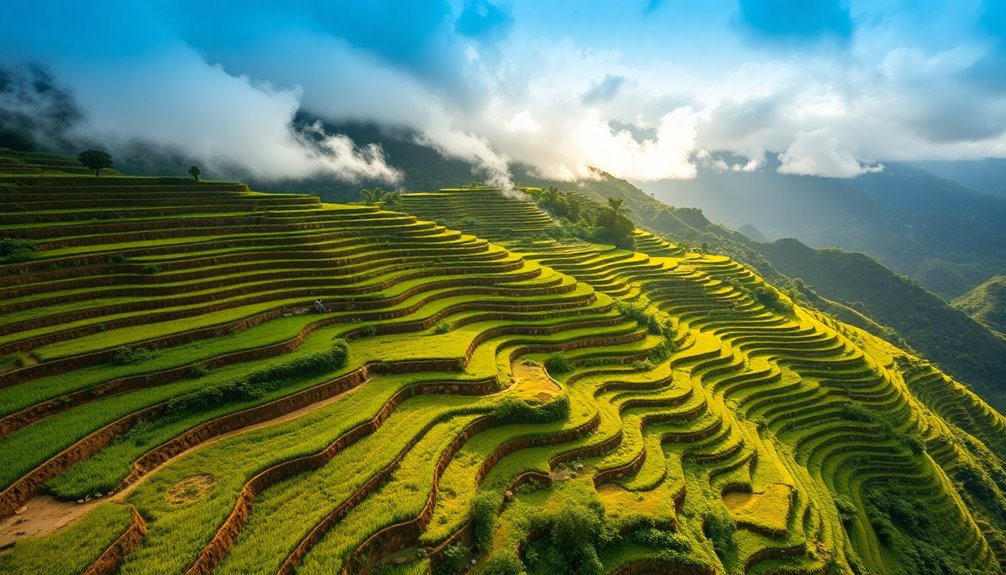
Farming on terraces can present several challenges that farmers need to navigate carefully. One major hurdle is the significant initial investment in labor and materials, which can be tough for economically disadvantaged regions.
Regular maintenance is essential to prevent soil erosion and issues with water management, such as waterlogging or uneven distribution. Extreme weather can exacerbate these problems, increasing the risk of landslides and damage to your terraces.
Achieving effective water retention is another concern; oversaturation can lead to crop failure if not managed properly.
To succeed in terrace farming, you'll need careful planning and community involvement, as improper designs or a lack of local knowledge can undermine your agricultural practices and overall success.
Soil Conservation Techniques
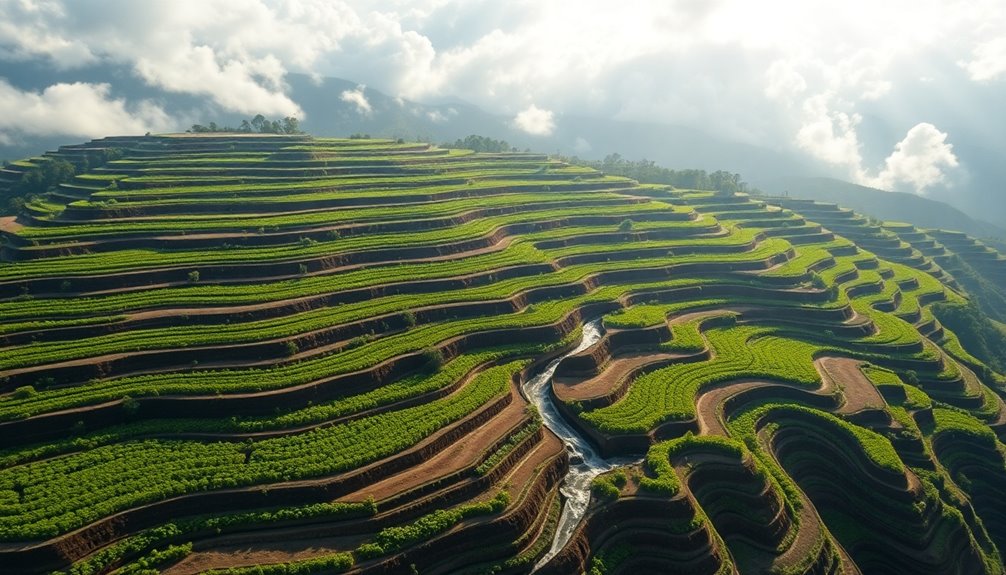
Managing the challenges of terrace farming naturally leads to the exploration of effective soil conservation techniques. By implementing these practices, you can greatly reduce soil erosion and enhance water retention on steep lands.
Here are some key techniques to take into account:
- Construct terraces to slow down runoff water and minimize nutrient loss.
- Use vegetation to stabilize soil and prevent erosion.
- Implement crop rotation to maintain soil fertility and replenish nutrients.
- Regularly maintain drainage systems to guarantee proper water flow.
- Apply sustainable agricultural practices to enhance soil health.
Step-by-Step Guide to Implementation
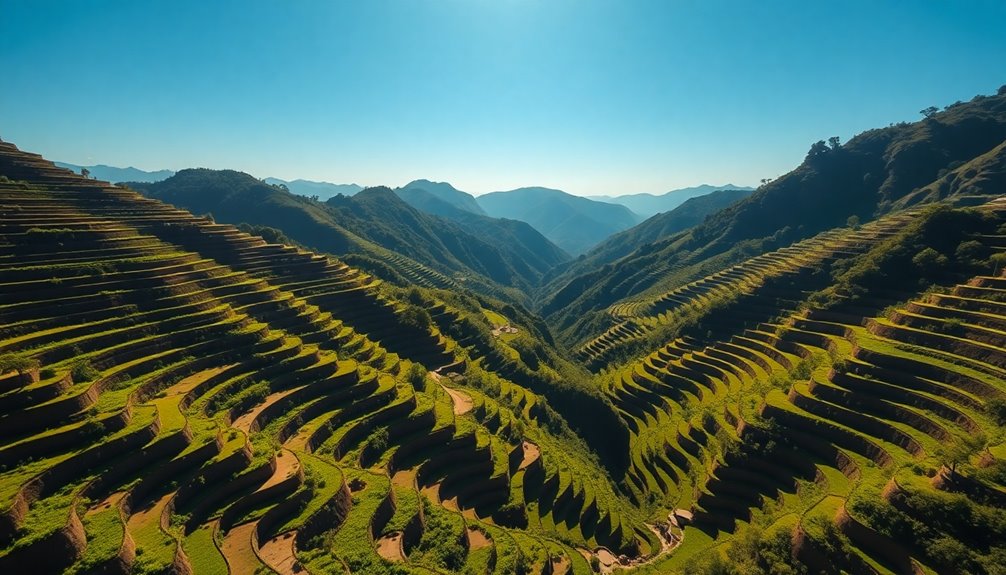
When you're ready to implement terrace farming, start by evaluating the slope's angle and soil type. This helps you determine the best terracing method, like bench, contour, or parallel terracing.
Next, mark the contour lines using stakes and string to align each terrace level with the land's natural contours, enhancing water management and erosion control.
Construct sturdy retaining walls from local materials to hold back soil and prevent erosion. Establish a drainage system by creating channels to direct excess water away, avoiding waterlogging.
Regularly maintain the terraces by checking for erosion, replanting vegetation along edges, and practicing crop rotation to boost soil fertility. These agricultural practices guarantee your terraces remain viable and productive over time.
Global Examples of Terrace Farming
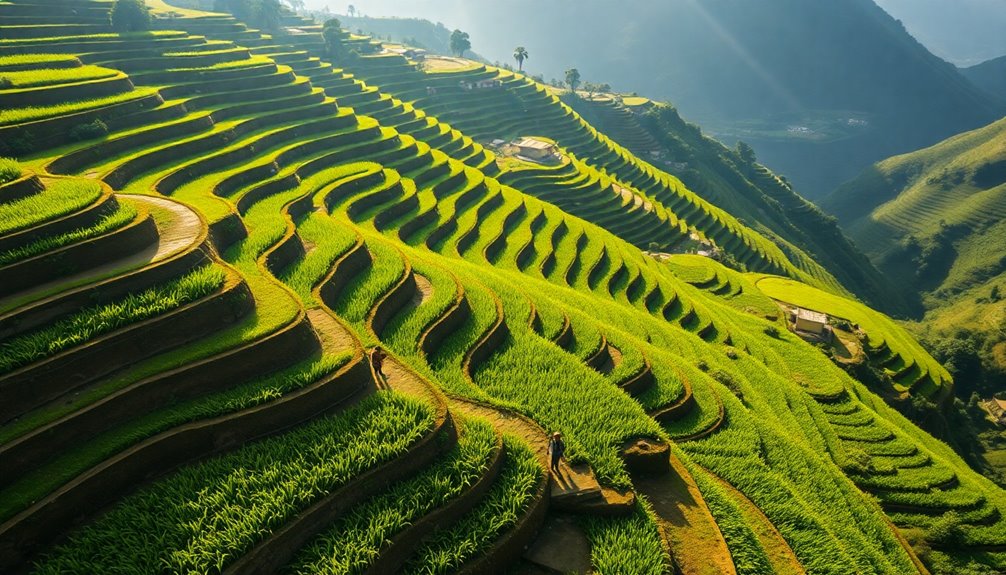
Exploring global examples of terrace farming reveals a rich tapestry of agricultural innovation adapted to diverse landscapes.
You can see how different cultures have mastered the art of terracing in agriculture to enhance land productivity and water management on steep slopes.
Here are a few notable examples:
- The Banaue Rice Terraces in the Philippines, a UNESCO World Heritage Site, showcase 2,000 years of rice cultivation.
- Machu Picchu's ancient terraces in Peru highlight agricultural ingenuity by growing diverse crops.
- Vietnam's Sa Pa Terraces blend scenic beauty with agricultural diversity.
- The Salinas De Maras in Peru demonstrate the versatility of salt-producing terraces.
- Bali's Subak system exemplifies cooperative water management, preserving cultural traditions while supporting rice terraces.
Frequently Asked Questions
What Is the Simple Definition of Terrace Farming?
Terrace farming is a method where you create flat, step-like levels on sloped land to grow crops.
This practice helps prevent soil erosion and makes it easier for rainwater to soak in, which keeps your plants hydrated.
By using terraces, you can effectively use hilly areas for farming, maximizing your land's potential.
It's an ancient technique that not only boosts food production but also supports sustainable agricultural practices.
What Is the Definition of Terrace Farming in AP Human Geography?
Imagine standing on a steep hillside, where farming seems impossible.
In AP Human Geography, terrace farming transforms that landscape into a series of flat, stepped surfaces. This method not only maximizes arable land but also combats soil erosion and manages water effectively.
You'll discover how communities adapt to their environments, enhancing food security and sustaining livelihoods.
It's a brilliant technique that underscores the harmony between agriculture and geography, revealing nature's potential.
What Three Ways Does Terrace Farming Help the Farmer?
Terrace farming helps you in three significant ways.
First, it maximizes your land usage by converting steep slopes into flat fields, boosting your cultivation area.
Second, it prevents soil erosion, retaining essential nutrients and enhancing soil fertility.
Finally, it improves water management by slowing runoff, ensuring your crops receive adequate moisture.
What Are the Pros and Cons of Terracing?
Imagine you're a farmer on a hilly plot, using terrace farming. The pros include increased crop yields and reduced soil erosion, giving your land a fighting chance against heavy rains.
However, constructing those terraces can be labor-intensive and costly. If you don't maintain them, you risk soil erosion and potential landslides.
Plus, you might find your crop options limited, as not all plants thrive in terraced conditions. Balancing these factors is essential for success.
Conclusion
In summary, terrace farming not only maximizes your land's potential but also plays an essential role in sustainable agriculture. Did you know that this ancient practice can reduce soil erosion by up to 90% compared to conventional farming? By implementing the techniques we've discussed, you can boost your crop yields while conserving important soil resources. Embracing terrace farming could be your key to a more productive and eco-friendly approach to agriculture. Get started and see the difference for yourself!

